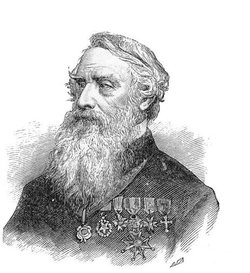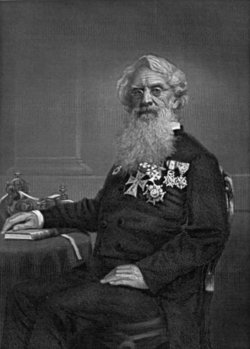Samuel F. B. Morse
|
|
Samuel Finley Breese Morse (April 27, 1791 – April 2, 1872) was an American inventor, and painter of portraits and historic scenes; he is most famous for inventing the electric telegraph and Morse code.
| Contents |
Biography
Early years
He was born in Charlestown, Massachusetts, the first child of geographer and pastor Jedidiah Morse and Elizabeth Ann Breese Morse. After attending Phillips Academy as a child, he attended college at 14. He devoted himself to art and became a pupil of Washington Allston, a well-known American painter. While at Yale University, he attended lectures on electricity from Benjamin Silliman and Jeremiah Day. He earned money by painting portraits. In 1810, he graduated from Yale University. Morse later accompanied Allston to Europe in 1811.
Morse invented a marble-cutting machine that could carve three dimensional sculptures in marble or stone. Morse couldn't patent it, however, because of a pre-existing 1820 Thomas Blanchard design. In 1823, Morse opened an art studio in New York City. In 1825, Morse painted Marquis de Lafayette's portrait (for $1,000). On February 7 of that same year, Morse's wife, Lucretia, died suddenly. She was buried before he returned to New Haven.
In 1837, Morse had invented the electrical telegraph, based on Hans Christian زsted's discovery in 1820 of the relationship between electricity and magnetism. In 1832, Morse developed the idea of electromagnetic telegraphy, during conversations with Dr. Charles T. Jackson. (Later, Dr. Jackson would bring a legal case over the telegraph, which he would ultimately lose.) Morse prototyped an electromagnetic recording telegraph and dot-and-dash code system (a signalling alphabet) in his sketchbook.
When studying in Rome in 1830, he became acquainted with the Danish sculptor Bertel Thorvaldsen; the two artists would sometimes take walks together at night among the ancient ruins. Morse also painted Thorvaldsen's portrait. In the fall of 1835, Morse built and demonstrated a recording telegraph with a moving paper ribbon. At the beginning of 1836, Morse demonstrated his recording telegraph to Dr. Leonard Gale. Also in 1836, Morse ran unsuccessfully for Mayor of New York on a Nativist ticket, receiving 1,496 votes.
Later years
In 1836 Morse finished his first working prototype of the telegraph. It used a one-element battery and a simple electromagnet. This prototype only worked over short distances of about 40ft or less. In winter 1836-1837 Morse showed his prototype to Leonard Gale, professor of chemistry at New York University, where Morse taught painting. Gale was aware of the works of Joseph Henry on electromagnetic relays. Based on this knowledge Gale suggested several improvements and also urged Morse to read Henry's 1831 paper, which described these improvements. With these improvements Morse and Gale were able to record messages through ten miles of wire. In September of the same year, Alfred Vail, then student at New York University, witnessed a demonstration of the telegraph. Vail's father Stephen Vail was a well-connected tinkerer, inventor, lawyer, community leader, and technology investor. He helped to finance the work on the telegraph.
In 1838, Morse changed the telegraphic cipher, from a telegraphic dictionary with number code to a code for each letter. Whether Alfred Vail was the actual inventor of this simpler code has been debated since the earliest days. According to much of the literature on the subject Vail was indeed the actual inventor, although Morse and his descendants claimed otherwise.
On January 24, Morse demonstrated the telegraph to colleges. On February 8, 1838, Morse first publicly demonstrated the electrical telegraph to a scientific committee at the Franklin Institute in Philadelphia, Pennsylvania (the first time it worked was on January 6). On February 21, Morse demonstrated the telegraph to President Martin Van Buren and his cabinet. Shortly afterwards, U.S. House of Representatives Committee on Commerce chairman F. O. J. Smith (Maine) became a partner with Morse (and proposed a bill in Congress, which didn't pass, for a $30,000 telegraph line project).
In 1839, Morse published (from Paris) the first American description of daguerreotype photography by Louis Daguerre. Morse pioneered American daguerreotypes. In 1844 Morse sent the telegraph message "What hath God wrought?" (Bible, Numbers 23:23) from Washington, DC to Baltimore, Maryland.
In the 1850s, Morse came to Copenhagen and visited the Thorvaldsen Museum, where the sculptor's grave is in the inner courtyard. He was received by King Frederick VII, and he expressed his wish to donate his portrait from 1830 to the king. The Thorvaldsen portrait today belongs to Queen Margaret II.
See also
- Main: Telegraphy, Electricity, Electrical telegraph, Morse code, Eponym, Daguerreotype, Semaphore
- Morse, Life magazine, Microwave, Photography
- People: Lord Kelvin, Joseph Henry, Cyrus West Field, Ezra Cornell, Washington Allston
- Lists: List of inventors, List of people on stamps of the United States, List of painters, Timeline of communication technology, List of famous cemeteries, Timeline of invention, Transatlantic telegraph cable, List of inventions named after people, List of inventors, List of Unitarian Universalists
- Science in the United States : Timeline of United States history (1820-1859), United States technological and industrial history
- Other: Compromise Generation
- Places: Yale University, Phillips Academy, Morristown, New Jersey, Green-Wood Cemetery, Charlestown, Massachusetts, Harkness Tower
External links
General
- " Samuel F. B. Morse Papers (http://memory.loc.gov/ammem/sfbmhtml/sfbmhome.html)". LOC.
- "Morse Timeline (http://memory.loc.gov/ammem/sfbmhtml/timeline01.html)". LOC.
- "Samuel Finley Breese Morse (http://www.acmi.net.au/AIC/MORSE_BIO.html): 1791 - 1872". Adventures in Cybersound.
- Calvert, J. B., "Hear American Morse (http://www.du.edu/~jcalvert/tel/heartele.htm): how it sounded on a sounder". September 20, 2000
- "Samuel F. B. Morse (http://www.invent.org/hall_of_fame/106.html)". National Inventors Hall of Fame.
- "Samuel F. B. Morse (http://www.npg.si.edu/edu/brush/guide/unit2/morse.html)". Unit 2: Those Inventive Americans. Smithsonian Institution, 2001.
- "Morsum Magnificat (http://www.morsum.demon.co.uk/), The magazine". Wistanswick, Market Drayton, Shropshire.
- Katz, Eugenii, "Samuel Finley Breese Morse (http://chem.ch.huji.ac.il/~eugeniik/history/morse.html)". Biosensors & Bioelectronics.
- Jones, R. Victor, "Electromagnetic Telegraphy (http://people.deas.harvard.edu/~jones/cscie129/lectures/lecture5/elecmag_tel/morse_tel.html) The Morse-Vail-Henry Telegraph". Deas.harvard.
- Casale, John, "Signature of the Father (http://www.telegraph-history.org/samuel-morse/signature.html)". W2NI. Troy, New York.
- Samuel Morse - the inventor of the Morse Telegraph System (http://www.radio-electronics.com/info/radio_history/morse/sfbmorse.php) Radio-Electronics.Com
Court Cases
- "O'Reilly, et al. v. Morse, et al. (http://www.law.pitt.edu/madison/patent/supplement/oreilly_v_morse.html)", 56 U.S. 62 (1853). Law.pitt.edu.
Stamps
- Reinhardt, Joachim, "Samuel F. B. Morse (http://www.th.physik.uni-frankfurt.de/~jr/gif/stamps/sm_morse.jpg) (1791-1872) Cambodcha, 2001", Physics-Related Stamps (http://www.th.physik.uni-frankfurt.de/~jr/physstamps.html). March 27, 2004.
- Reinhardt, Joachim, "Samuel F. B. Morse (http://www.th.physik.uni-frankfurt.de/~jr/gif/stamps/s_morse2.jpg) (1791-1872) Congo, 1988". Physics-Related Stamps (http://www.th.physik.uni-frankfurt.de/~jr/physstamps.html). March 27, 2004.


